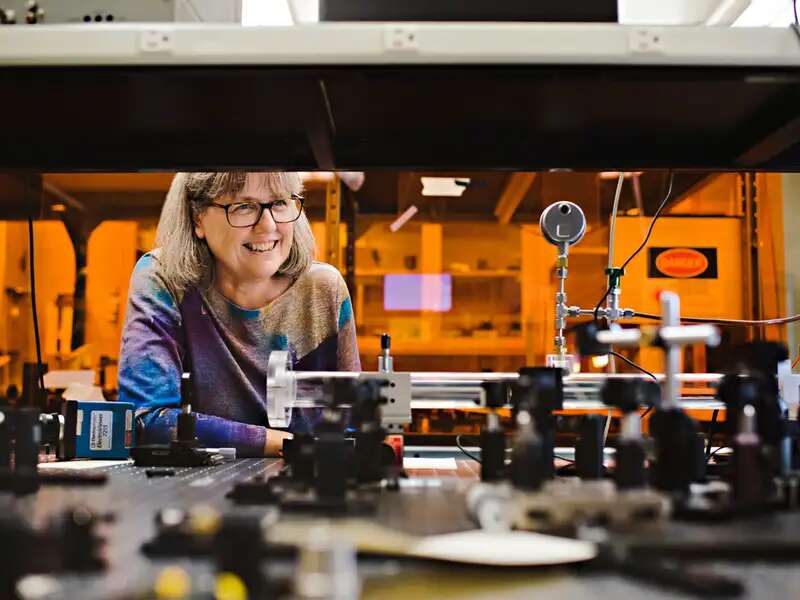 Reshmi Mukherjee, the Helen Goodhart Altschul Professor of Physics and Astronomy, has spent years staring into space. Literally. She begins her introductory physics class on noctilucent clouds — clouds seen in polar skies and only at twilight — which some believe are symptoms of climate change. Mukherjee often takes Barnard and Columbia students in her research group to the Fred Lawrence Whipple Observatory 50 miles south of Tucson, Arizona, to research astrophysical sources of high-energy gamma rays with VERITAS (Very Energetic Radiation Imaging Telescope Array System), the telescope system operated by a global network of scientists, for which she is the international spokesperson. Nearly 100 scientists and research students collaborate on the system’s four 40-foot gamma-ray telescopes to better find gamma rays emitted from supernova remnants, exotic galaxies, black holes, neutron stars, and other immensely powerful astrophysical sources.
Reshmi Mukherjee, the Helen Goodhart Altschul Professor of Physics and Astronomy, has spent years staring into space. Literally. She begins her introductory physics class on noctilucent clouds — clouds seen in polar skies and only at twilight — which some believe are symptoms of climate change. Mukherjee often takes Barnard and Columbia students in her research group to the Fred Lawrence Whipple Observatory 50 miles south of Tucson, Arizona, to research astrophysical sources of high-energy gamma rays with VERITAS (Very Energetic Radiation Imaging Telescope Array System), the telescope system operated by a global network of scientists, for which she is the international spokesperson. Nearly 100 scientists and research students collaborate on the system’s four 40-foot gamma-ray telescopes to better find gamma rays emitted from supernova remnants, exotic galaxies, black holes, neutron stars, and other immensely powerful astrophysical sources.
This year, VERITAS marks its 10th anniversary since the first full-scale observations began. The milestone was recently celebrated at a conference co-sponsored by Barnard that included presentations led by Mukherjee and others highlighting VERITAS’s history, updates, and scientific accomplishments. During her presentation, Mukherjee explained that today this telescope system can detect a source in less than half the time it took 10 years ago. As a result, her team has amassed more than 12,000 hours of data and detected high-energy gamma rays emitted from sources in the Milky Way Galaxy such as supernova remnants, pulsars, and extremely powerful distant astrophysical sources such as gamma-ray blazars that are thought to be powered by super-massive black holes in their centers. In February 2017, VERITAS caught a flood of gamma rays from a quasar believed to host a binary supermassive black hole, roughly 18 billion times more massive than our sun, among the largest known.
In April 2015, VERITAS together with NASA’s Fermi Gamma-Ray Space Telescope caught an outburst of high-energy gamma rays from its most distant galaxy (light that took more than 7.5 billion years to reach us on Earth). “The gamma rays that traveled billions of light years, avoiding obliteration in the cosmic fog [generated by astrophysical objects such as stars and galaxies that emit light], give us an opportunity to learn about the star formation history of the universe," says Mukherjee.
Gamma-ray astronomy began in the 1960s as a challenging discipline with several technological hurdles; gamma rays with energies of more than a trillion electron volts (1 TeV) are so rare they can only be studied from the ground, indirectly, with very large telescopes. The need to see beyond our stars led to the construction of the first gamma-ray telescope at Mount Hopkins (Arizona), half a century ago, in 1967. Forty years later, in 2007, the first full-scale observations began using VERITAS. Today in gamma-ray astronomy, more than 200 objects have been detected, and more than 1,350 scientists are developing the next-generation TeV gamma-ray observatory. Barnard College is part of an international collaboration carrying out R&D toward the development of new telescopes for the future large-scale Cherenkov Telescope Array. At the moment, VERITAS is the only gamma-ray system currently operating in the United States and is the most-powerful instrument of its kind. From the very beginning, Mukherjee has been at the forefront of this research, helping to lead astrophysicists to galaxies both near and far away.
For more on Mukherjee’s work with VERITAS: Check out The Great Escape and Research @ Barnard Is...


